As a civil engineer with a deep understanding of SEO content structuring, I’ve spent years mastering the art of concrete patio construction. One of the most frequently asked questions I encounter is, “How thick should a concrete patio be?” It’s a crucial question, as the thickness of your concrete patio can significantly impact its durability, functionality, and lifespan.
In this comprehensive guide, we’ll delve into the intricacies of determining the ideal thickness for your concrete patio. We’ll explore the factors that influence this decision, the implications of different thickness levels, and the recommended standards based on various scenarios. Whether you’re a homeowner planning to build a new patio or a professional looking to enhance your knowledge, this article is designed to provide you with in-depth, practical insights drawn from real-life experience and professional expertise.
Table of Contents
Understanding Basic Concrete Patio Dimensions
The dimensions of a concrete patio are crucial to its functionality, durability, and aesthetic appeal. The thickness of the concrete slab, in particular, is a vital aspect that requires careful consideration. This dimension directly influences the patio’s ability to withstand various loads and weather conditions.
The standard thickness for a concrete patio slab is typically around 4 inches (or about 10 centimeters).
However, this measurement can vary based on several factors, such as the purpose of the patio, the type of soil it’s built on, and the climate of the area.
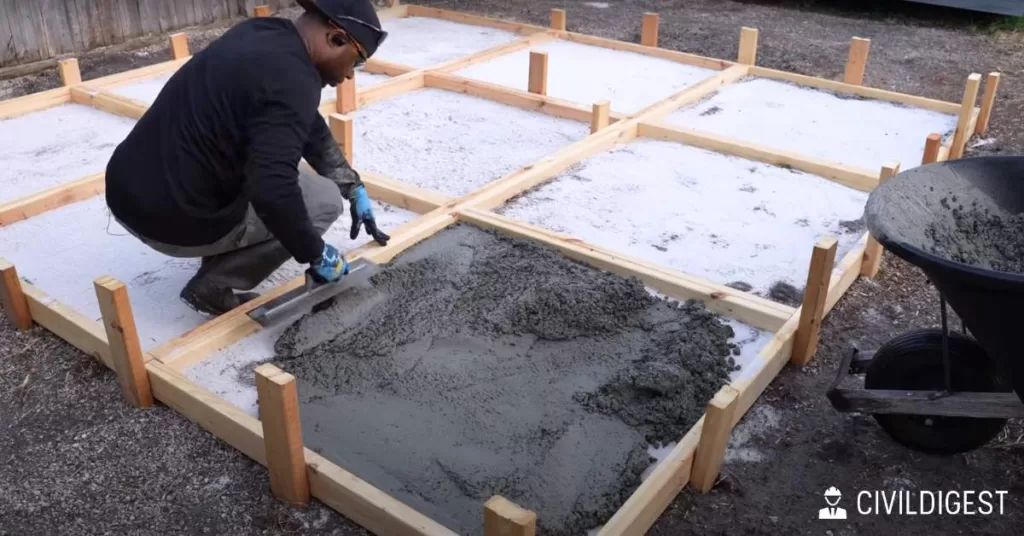
Factors to Determine Concrete Slab Thickness
Determining the appropriate thickness for a concrete patio slab involves considering several factors. Here are some of the most significant ones:
- Purpose of the Patio: The intended use of the patio significantly influences the slab thickness. For instance, a patio designed for light foot traffic may only require a 4-inch slab. However, if you plan to place heavy furniture or equipment on the patio, a thicker slab may be necessary.
- Soil Type: The type of soil on which the patio is constructed can also affect the required slab thickness. For example, a patio built on soft, sandy soil may need a thicker slab than one built on firm, compacted soil.
- Climate: The local climate plays a significant role in determining the slab thickness. In colder climates, where the ground is subject to freeze-thaw cycles, a thicker slab may be necessary to prevent cracking and other damage.
- Load-Bearing Capacity: The load-bearing capacity of the slab is directly proportional to its thickness. A thicker slab can support heavier loads without cracking or sagging.
- Reinforcement: The use of reinforcement, such as rebar or wire mesh, can enhance the strength of the slab, allowing for a thinner slab in some cases.
| Factor | Influence |
|---|---|
| Purpose of the Patio | Determines the expected load on the patio |
| Soil Type | Influences the stability of the base |
| Climate | Affects the durability and lifespan of the patio |
| Load-Bearing Capacity | Directly related to slab thickness |
| Reinforcement | Can enhance strength, allowing for a thinner slab |
By considering these factors, you can determine the most suitable thickness for your concrete patio slab, ensuring it will serve its purpose effectively and last for many years.
Concrete Slab Thickness by Application
The thickness of a concrete slab can vary significantly depending on its intended use. Here is a brief overview of the recommended slab thickness for different applications:
- Walkways and Patios: These areas typically require a slab thickness of 4 inches for adequate strength and durability.
- Driveways: For standard passenger vehicles, a slab thickness of 4 to 5 inches is usually sufficient. However, if the driveway will be used by heavier vehicles, such as RVs or trucks, a thickness of 5 to 6 inches is recommended.
- Garage Slabs: The recommended thickness for garage slabs is 6 inches to support the weight of vehicles.
- Industrial Floors: These typically require a slab thickness of 6 to 8 inches to withstand heavy machinery and high traffic.
| Application | Recommended Thickness (inches) |
|---|---|
| Walkways and Patios | 4 |
| Driveways | 4-6 |
| Garage Slabs | 6 |
| Industrial Floors | 6-8 |
Thicknesses for Different Types of Poured Concrete
The thickness of poured concrete can also vary depending on the type of concrete used. Here are some general guidelines:
- Standard Concrete: This is typically poured at a thickness of 4 inches for most residential applications.
- Reinforced Concrete: When reinforced with steel rebar or wire mesh, concrete can often be poured at a thinner thickness, typically around 3 to 4 inches.
- High-Strength Concrete: This type of concrete, which is designed to withstand higher loads, is often poured at a thickness of 5 to 6 inches.

Source: Reinforced Concrete
How Thick Should Concrete Be for Walking?
For areas intended for foot traffic, such as walkways and patios, a concrete slab thickness of 4 inches is generally recommended.
This thickness provides a good balance of strength and cost-effectiveness for these types of applications. However, if the area will be subject to heavy foot traffic or occasional vehicle use, a thicker slab may be necessary.
How Thick is a Balcony Slab?
The thickness of a concrete balcony slab can vary depending on factors such as the size of the balcony, the expected load, and local building codes. However, a common rule of thumb is to use a slab thickness of at least 4 inches for small balconies. For larger balconies or those expected to carry heavier loads, a slab thickness of 6 to 8 inches may be more appropriate.
| Balcony Size | Recommended Thickness (inches) |
|---|---|
| Small Balconies | 4 |
| Large Balconies | 6-8 |
Remember, these are general guidelines. It’s crucial to consult with a structural engineer or a professional contractor to determine the most suitable slab thickness for your specific project. They will consider factors such as local building codes, the type of reinforcement used, and the specific conditions of your site to provide a more accurate recommendation.
Recommended Thickness for Concrete Patios
The recommended thickness for a concrete patio largely depends on its intended use. For patios that will primarily be used for foot traffic, outdoor dining, or light recreational activities, a 4-inch thick slab is typically sufficient. This thickness provides a good balance of strength and cost-effectiveness, making it the standard choice for many homeowners.
However, if you plan to place heavy objects such as a hot tub or large outdoor kitchen on your patio, you may need a thicker slab. In such cases, a thickness of 6 inches or more may be necessary to safely support the additional weight. Always consult with a professional to determine the most suitable slab thickness for your specific needs.
Delving into 4-Inch Concrete Properties
A 4-inch thick concrete slab is a common choice for many applications due to its excellent balance of strength, durability, and cost-effectiveness. Here, we delve into the properties of a 4-inch concrete slab.
Is 4 inches of concrete enough for a patio?
For most patios, a 4-inch thickness is indeed sufficient. This thickness can comfortably support the weight of patio furniture, a barbecue grill, and the regular foot traffic a patio typically receives. However, if you plan to place significantly heavy objects on the patio, such as a hot tub or outdoor fireplace, a thicker slab may be necessary.
| Patio Use | Recommended Thickness (inches) |
|---|---|
| Regular foot traffic, light furniture | 4 |
| Heavy furniture, outdoor kitchen | 5-6 |
| Hot tub, outdoor fireplace | 6-8 |
How Long to Walk on 4 Inch Concrete?
The time you should wait before walking on a newly poured 4-inch concrete slab depends on several factors, including the type of concrete mix used, the temperature and humidity at the time of pouring, and the specific curing process used.
However, as a general rule of thumb, you should wait at least 24 hours before walking on a new concrete slab.
For heavy objects or high foot traffic, it’s best to wait at least 7 days to allow the concrete to reach about 70% of its total strength. Always follow the recommendations of your concrete supplier or contractor for the best results.
| Activity | Recommended Curing Time |
|---|---|
| Walking | 24 hours |
| Placing furniture | 3 days |
| Heavy objects/High foot traffic | 7 days |
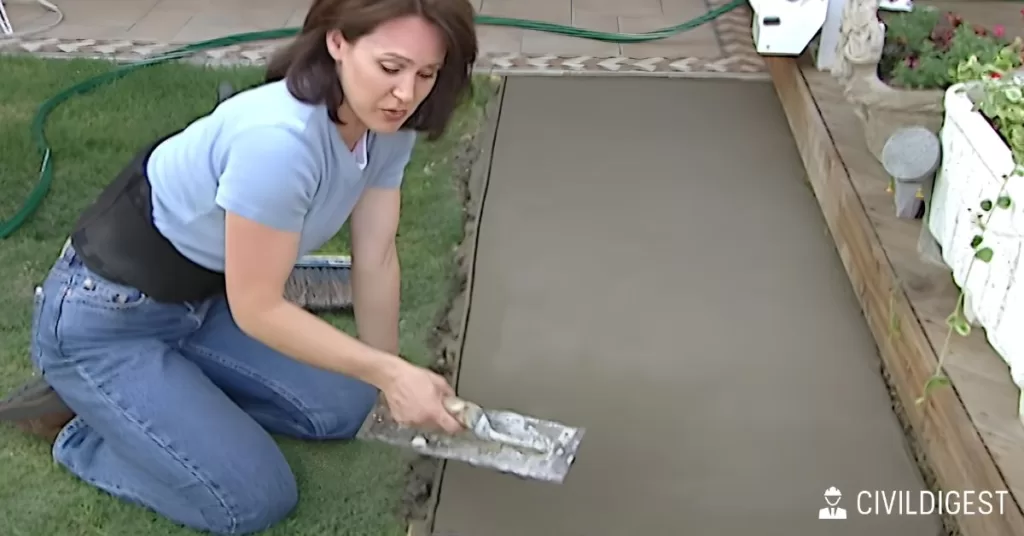
How Strong is 4 Inch Concrete?
The strength of a 4-inch concrete slab depends on several factors, including the type and quality of the cement, the aggregate used, and the water-to-cement ratio. However, a standard 4-inch slab made with typical concrete mix is quite robust and can withstand significant loads.
The compressive strength of concrete is typically measured in pounds per square inch (PSI). Standard residential concrete usually has a strength of around 2,500 to 3,000 PSI, though high-strength concrete can reach 4,000 PSI or more.
How Much Weight Can a 4-Inch Concrete Slab Hold?
The weight that a 4-inch concrete slab can hold depends on its strength, which, as mentioned above, is influenced by factors such as the concrete mix and the use of reinforcement.
As a general guideline, a standard 4-inch slab with a strength of 3,000 PSI can safely support a live load of up to 2,000 pounds per square foot (PSF). However, this can vary based on the specific conditions of your project, so it’s always best to consult with a professional.
| Concrete Strength (PSI) | Load Capacity (PSF) |
|---|---|
| 2,500 | 1,500 |
| 3,000 | 2,000 |
| 4,000 | 2,500 |
Do You Need Rebar for a 4-Inch Slab?
Whether or not you need rebar for a 4-inch slab depends on the slab’s intended use and the local building codes. Generally, for a standard patio slab that will primarily be used for foot traffic, rebar is not necessary.
However, if the slab will be subject to heavy loads or if it’s in an area prone to ground movement or freeze-thaw cycles, using rebar can significantly increase its strength and durability. When in doubt, it’s best to consult with a professional or your local building department.
Do You Need Wire Mesh for a 4-Inch Slab?
Like rebar, the need for wire mesh in a 4-inch slab depends on the slab’s intended use and the local building codes. Wire mesh can help to prevent cracking and increase the slab’s tensile strength, making it a good option for areas subject to heavy foot traffic or temperature fluctuations.
However, wire mesh must be properly positioned in the middle of the slab to be effective, which can be challenging in a 4-inch slab. Therefore, for many residential patios, wire mesh is often not used unless required by local building codes.
How to Measure the Stability of a Four-Inch-Thick Concrete Slab
Measuring the stability of a 4-inch concrete slab involves assessing its load-bearing capacity and checking for signs of damage or instability. Here are the steps involved:
- Visual Inspection: Look for visible signs of instability, such as cracks, uneven surfaces, or areas where the concrete is sinking or bulging.
- Load Test: Apply a load to the slab and observe how it reacts. If the slab can support the load without cracking or deforming, it’s likely stable.
- Penetration Resistance Test: This involves using a device to measure the resistance of the concrete to penetration. Higher resistance indicates a more stable slab.
- Ultrasonic Pulse Velocity Test: This non-destructive test measures the time it takes for an ultrasonic pulse to travel through the concrete. Faster travel times indicate a more stable and dense slab.
Remember, these tests should be carried out by a qualified professional to ensure accurate results.
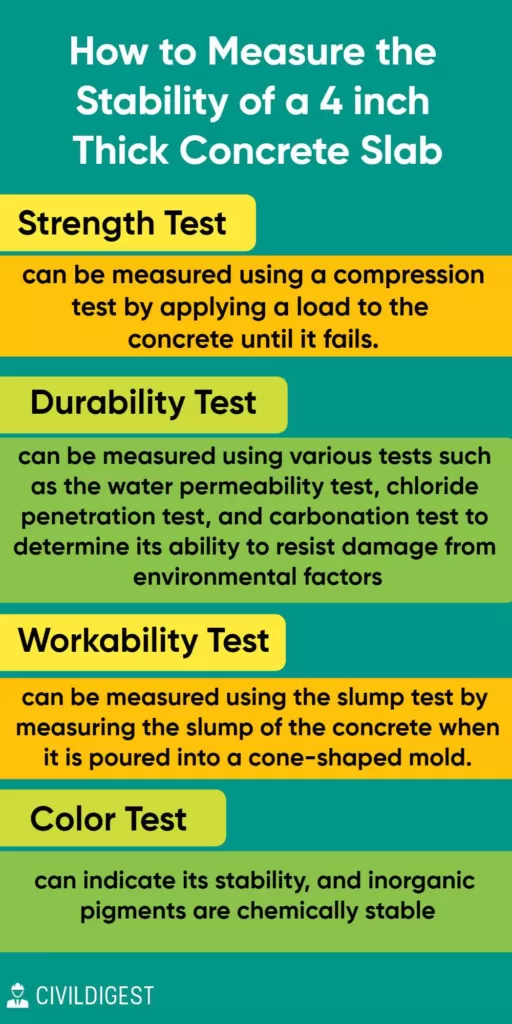
Reinforcement Options for Concrete Patios
Reinforcement can significantly enhance the strength and durability of a concrete patio. Here are some common reinforcement options:
- Rebar: This is a steel bar or mesh of steel wires used to increase the tensile strength of the concrete.
- Wire Mesh: This is typically used in thinner slabs to prevent cracking and provide additional strength.
- Fiber Reinforcement: These are small, synthetic fibers mixed into the concrete, which can help to reduce shrinkage cracking and improve the slab’s durability.
- Post-Tension Cables: These are tensioned after the concrete has hardened, helping to keep the slab compressed and resist cracking.
| Reinforcement Type | Benefits |
|---|---|
| Rebar | Increases tensile strength |
| Wire Mesh | Prevents cracking in thin slabs |
| Fiber Reinforcement | Reduces shrinkage cracking |
| Post-Tension Cables | Resists cracking, keeps slab compressed |
Addressing Concerns of Thin Concrete Layers
When it comes to concrete, thicker is often better for durability and strength. However, there may be situations where a thinner slab is desired or necessary. In such cases, it’s important to address the potential concerns associated with thin concrete layers.
Can I Pour a 2 Inch Concrete Slab?
Pouring a 2-inch concrete slab is possible, but it comes with several challenges and potential drawbacks. First, a thin slab will be less durable and more prone to cracking than a thicker slab. It will also have a lower load-bearing capacity, making it unsuitable for areas with heavy traffic or loads.
If you need to pour a thin slab, it’s crucial to use a high-strength concrete mix and consider using reinforcement to enhance the slab’s strength and durability. Additionally, the base upon which the slab is poured must be well-prepared and compacted to provide adequate support.
| Consideration | Importance |
|---|---|
| High-strength concrete mix | Enhances strength and durability |
| Reinforcement | Prevents cracking and increases load-bearing capacity |
| Well-prepared base | Provides necessary support for the thin slab |
Is 2 Inch Thick Concrete Strong?
A 2-inch thick concrete slab may seem adequate for minor applications, but it’s not typically recommended for patios. The strength of concrete is not solely determined by its thickness, but also by the quality of the materials used and the compaction of the ground beneath it. However, a 2-inch slab lacks the structural integrity needed to withstand the weight and usage of a patio, making it prone to cracking and damage over time.
Can I Pour a 3 Inch Concrete Slab?
Yes, you can pour a 3-inch concrete slab, but it’s not advisable for a patio. The standard thickness for a concrete patio is 4 inches. This thickness provides the necessary strength and durability for regular foot traffic, outdoor furniture, and the elements. A 3-inch slab may not provide the same level of stability and could lead to issues such as cracking or sinking.
What Happens if Concrete is Too Thin?
When concrete is too thin, it lacks the structural integrity needed to withstand pressure and wear. This can lead to a variety of problems:
- Cracking: Thin concrete is more susceptible to cracking, especially under heavy loads or during freeze-thaw cycles.
- Curing Issues: Thin slabs may cure too quickly, leading to a weaker structure.
- Durability: Thin concrete patios may not withstand the test of time, requiring more frequent repairs or replacement.
How Thick Does Concrete Need to Be to Not Crack?
The thickness of a concrete slab required to prevent cracking depends on several factors, including the type of load it will bear, the quality of the concrete, and the preparation of the underlying soil. However, for most residential patios, a thickness of 4 inches is recommended. This thickness, combined with proper reinforcement and control joints, can help prevent cracking and ensure the longevity of the patio.
Concrete Patio Thickness for Different Climate Zones
The thickness of a concrete patio can also be influenced by the climate in which it’s located. Here’s a general guide:
- Mild Climates: In areas with mild climates that don’t experience extreme temperature fluctuations, a standard 4-inch slab is typically sufficient.
- Cold Climates: In colder climates prone to freeze-thaw cycles, a thicker slab of 5 inches may be recommended to withstand potential damage from frost heave.
- Hot Climates: In hot, dry climates, a standard 4-inch slab is usually adequate. However, additional considerations for preventing drying and cracking, such as using a concrete mix with a lower water-to-cement ratio, may be necessary.
- Wet Climates: In areas with high rainfall, proper drainage is critical to prevent water from pooling and weakening the slab. A standard 4-inch slab with a well-prepared base is usually sufficient.
Structural Considerations and Building Codes
When it comes to constructing a concrete patio, understanding the structural considerations and building codes is paramount. These guidelines not only ensure the safety and durability of your patio but also its compliance with local regulations. In this section, we’ll delve into the factors that determine whether or not you need to reinforce your concrete, the impact of cracks on the strength of concrete, and what the building codes dictate about slab thickness.
What Determines Whether or Not You Reinforce Concrete?
The decision to reinforce concrete is influenced by several factors:
- Load-Bearing Capacity: If the concrete is expected to bear heavy loads, such as vehicles or heavy furniture, reinforcement is necessary to increase its load-bearing capacity.
- Size and Shape: Larger and irregularly shaped slabs are more prone to cracking and thus require reinforcement.
- Soil Conditions: Unstable or expansive soils can exert pressure on the slab, necessitating reinforcement to maintain integrity.
- Climate: In areas with freeze-thaw cycles or high seismic activity, reinforced concrete is necessary to withstand these conditions.
Do Cracks Weaken Concrete?
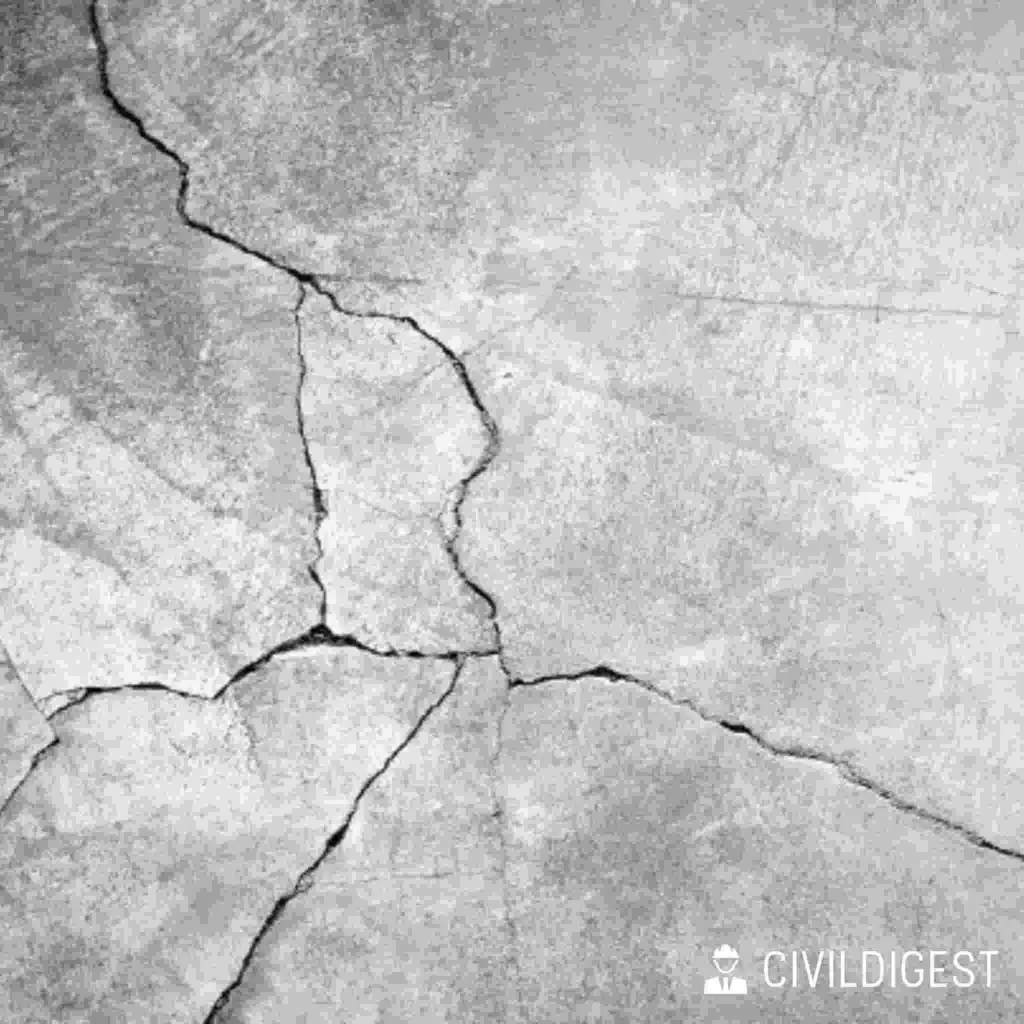
Yes, cracks can weaken concrete. They provide a pathway for water to penetrate, which can lead to erosion or freeze-thaw damage. Over time, cracks can expand, further compromising the structural integrity of the slab. Therefore, it’s crucial to address any cracks promptly to maintain the strength and longevity of your concrete patio.
What do Building Codes Say About Slab Thickness?
Building codes vary by location, but most mandate a minimum slab thickness for concrete patios. For example, the International Residential Code (IRC) suggests a minimum thickness of 3.5 inches for a concrete slab on grade. However, many experts recommend a thickness of 4 inches for residential patios to ensure durability and longevity. It’s important to check with your local building department to ensure you meet all code requirements. Here’s a general guide:
| Location | Code Requirement |
|---|---|
| Residential Patio | Minimum 3.5 inches |
| Driveways | Minimum 4 inches |
| Garage Slabs | Minimum 4 inches |
| Sidewalks | Minimum 4 inches |
Does a Concrete Patio Need Footings?
Whether a concrete patio requires footings depends on a few factors:
- Ground Stability: If the patio is being built on unstable or sloping ground, footings may be necessary to provide stability.
- Load: If the patio is expected to bear heavy loads, such as an outdoor kitchen or hot tub, footings can help distribute the weight evenly to prevent the slab from cracking or sinking.
- Climate: In areas prone to freeze-thaw cycles, footings that extend below the frost line can help prevent frost heave.
- Local Building Codes: Some local building codes may require footings for concrete patios. Always check with your local building department.
The thickness of a concrete patio for heavy loads depends on the type of load it will bear. However, as a general rule, a thickness of 5-6 inches is typically recommended for heavy loads such as outdoor kitchens, hot tubs, or if the patio will be used for parking vehicles. Here’s a general guide:
Concrete Patio Thickness for Heavy Loads
| Load Type | Recommended Slab Thickness |
|---|---|
| Light Foot Traffic | 4 inches |
| Heavy Furniture/Equipment | 5 inches |
| Vehicles | 6 inches |
Pouring and Finishing the Patio
Once you’ve determined the ideal thickness for your concrete patio and understood the structural considerations, it’s time to get your hands dirty with the actual construction process. This involves pouring the concrete slab and finishing it to perfection.
How to Pour a Concrete Patio Slab
Pouring a concrete patio slab involves several steps:
- Ground Preparation: Clear the area of any debris or vegetation and level the ground. You may need to excavate to the desired depth.
- Formwork Installation: Install wooden forms to contain the concrete. The forms should be sturdy and level.
- Reinforcement: If necessary, place rebar or wire mesh in the form to reinforce the concrete.
- Concrete Pour: Pour the concrete into the form, starting at one end and working your way to the other. Use a shovel or a rake to spread the concrete evenly.
- Finishing: Smooth the surface of the concrete with a float, then apply a broom finish for traction.
Do Concrete Patios Need Rebar?
Whether a concrete patio needs rebar (reinforcing steel bars) depends on the expected load and local building codes. Rebar can strengthen the slab and help prevent cracking. For a standard patio with light foot traffic, rebar may not be necessary. However, for larger patios or those expected to bear heavy loads, rebar is recommended.
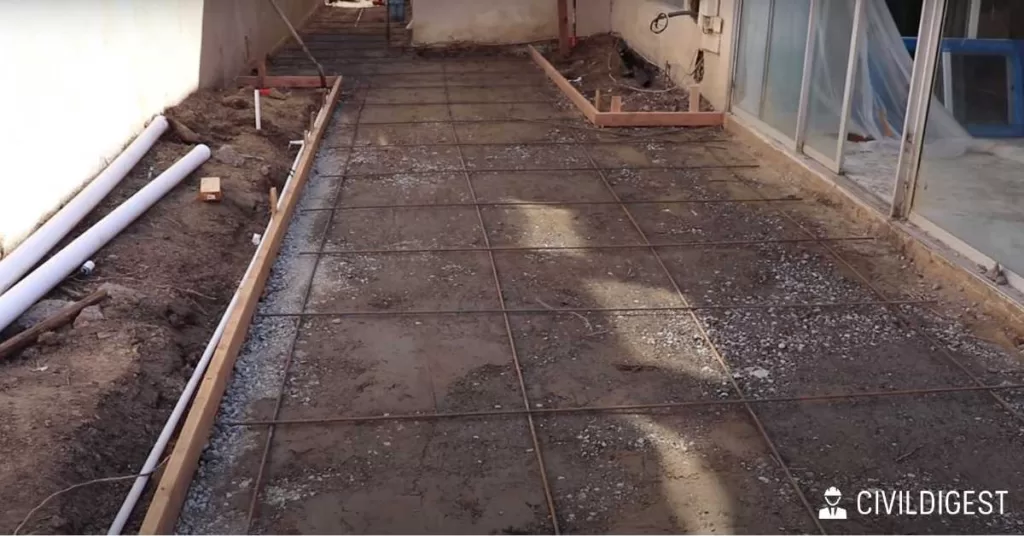
Prepare Ground
Ground preparation is a crucial step in pouring a concrete patio. Here’s how to do it:
- Clear the Area: Remove any grass, plants, or debris from the area.
- Level the Ground: Use a shovel and a rake to level the ground. You may need to add or remove soil to achieve a level surface.
- Compact the Soil: Use a plate compactor or hand tamper to compact the soil. This creates a stable base for the concrete.
- Install Formwork: Install wooden forms to contain the concrete. Ensure they’re level and secure.
Pour and Finish
After preparing the ground and installing the formwork, you’re ready to pour and finish the concrete:
- Pour the Concrete: Start at one end of the form and pour the concrete, spreading it evenly with a shovel or rake.
- Level the Concrete: Use a screed to level the concrete. Move it back and forth across the form to remove excess concrete and fill in low spots.
- Finish the Surface: After the concrete has started to set, use a float to smooth the surface. Then, apply a broom finish for traction.
Can You Pour Concrete Directly on Dirt?
Yes, you can pour concrete directly on dirt, but the ground must be properly prepared first. This involves clearing the area of vegetation and debris, leveling and compacting the soil, and installing formwork. Without these steps, the concrete may crack or shift over time.
Concrete Patio Design and Longevity Considerations
Designing a concrete patio is not just about its thickness or the materials used, but also about its shape, size, and overall design. These elements, coupled with the right thickness, can significantly impact the patio’s longevity.
What is the Best Shape for a Concrete Patio?
The best shape for a concrete patio depends on your specific needs, the layout of your yard, and your personal aesthetic preferences. Here are a few popular options:
- Rectangular: This is a classic choice that offers a clean, modern look. It’s also straightforward to construct.
- Circular: A circular patio can create a focal point in your yard and is ideal for fire pits or central seating areas.
- Freeform: If your yard has an irregular shape or if you want a more organic look, a freeform patio can be a good choice.
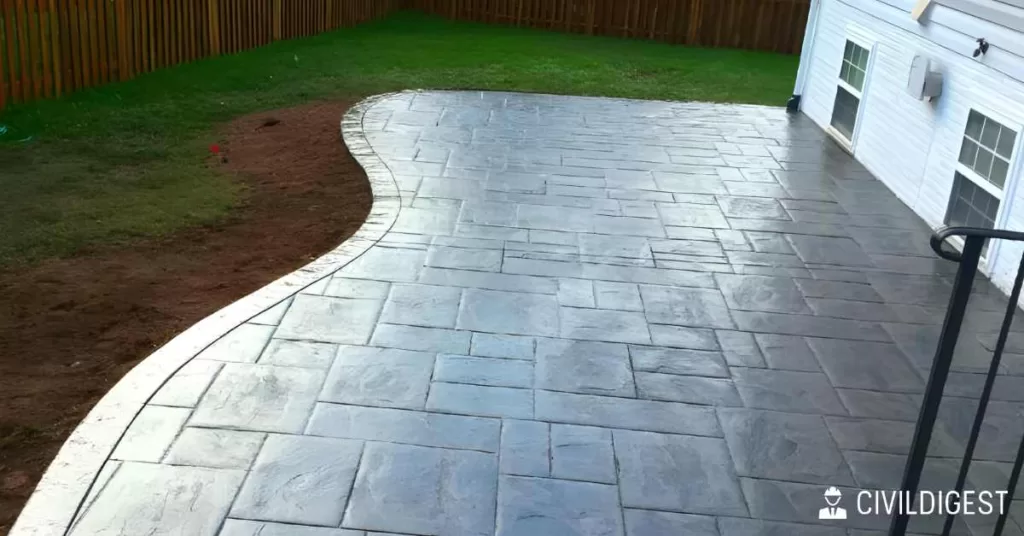
How Long do Concrete Slabs Last?
With proper installation and maintenance, a concrete patio can last between 25 to 30 years, or even longer. Factors that can affect the lifespan of a concrete slab include the quality of the concrete mix, the preparation of the underlying soil, and the use of reinforcement.
Can a Concrete Patio Be Too Thick?
Yes, a concrete patio can be too thick. While a thicker slab is generally stronger, it also requires more concrete, making it more expensive. Additionally, if the slab is too thick, it may not heat evenly, leading to potential discomfort for barefoot users. For most patios, a thickness of 4 inches is sufficient.
Deciding the Thickness of Your Patio’s Concrete Slab
The thickness of your patio’s concrete slab should be determined by several factors:
- Purpose: If your patio will bear heavy loads, such as a hot tub or outdoor kitchen, a thicker slab may be necessary.
- Soil Conditions: Unstable or expansive soils may require a thicker slab or additional reinforcement.
- Climate: In areas with freeze-thaw cycles, a thicker slab can help prevent frost heave damage.
Factors Affecting Concrete Patio Thickness
Several factors can affect the thickness of a concrete patio:
- Load: The expected load on the patio is one of the main factors. Heavier loads require a thicker slab.
- Soil Conditions: The condition of the underlying soil can affect the thickness. Unstable or expansive soils may require a thicker slab.
- Climate: The local climate can influence the thickness. In areas prone to freeze-thaw cycles, a thicker slab may be necessary to prevent damage.
- Local Building Codes: Local building codes often specify a minimum slab thickness.
Additional Aspects of Concrete Patio Construction
In this section, we’ll introduce you to a handy tool – the concrete patio calculator, which can simplify your construction process. We’ll also delve into the concepts of thick pours and structural pours, and their role in patio construction. Lastly, we’ll discuss the importance of concrete beams in providing structural support to your patio.
Concrete Patio Calculator
Estimating the amount of concrete needed for a patio can be done using a simple formula:
- Calculate the Area: Multiply the length by the width of the patio to get the area in square feet.
- Determine the Depth: Convert the thickness of the slab from inches to feet. For a 4-inch slab, this would be 4/12 = 0.33 feet.
- Calculate Volume: Multiply the area by the depth to get the volume in cubic feet.
- Convert to Cubic Yards: Since concrete is typically sold by the cubic yard, divide the volume by 27 (since there are 27 cubic feet in a cubic yard).
For example, for a 10×10 foot patio with a 4-inch slab:
Area = 10 x 10 = 100 square feet
Depth = 4/12 = 0.33 feet
Volume = 100 x 0.33 = 33 cubic feet
Cubic Yards = 33/27 = 1.22 cubic yards
So, you would need approximately 1.22 cubic yards of concrete.
This Concrete Patio Calculator tool takes the guesswork out of the equation, offering precise calculations based on the dimensions you provide. With inputs for width, length, and thickness, get real-time estimates in cubic yards, tailored to your specific project.
Related: Concrete Bag Calculator
Thick Pours
Thick pours, typically those over 5 inches, require special consideration. They may need additional reinforcement to prevent cracking, and the concrete mix may need to be adjusted for proper curing. Additionally, thick pours often require more time to set and cure, so plan accordingly.
Structural Pours
Structural pours are used for concrete structures that need to bear significant loads, such as foundations or retaining walls. These pours require high-strength concrete and often need reinforcement with rebar. They also require precise formwork to ensure the concrete is shaped correctly.
Concrete Beams
Concrete beams are used in construction to provide support for structures. They are typically reinforced with rebar and are designed to withstand both compression (from the weight of the structure) and tension (from bending forces). While not typically part of a patio construction, concrete beams can be used in related structures such as pergolas or outdoor kitchens.
Conclusion
Determining “how thick a concrete patio should be” is a question that requires careful consideration of several factors. As we’ve explored in this comprehensive guide, the thickness of your concrete patio is not a decision to be taken lightly. From understanding the basic patio dimensions to considering the implications of various thickness levels, every aspect plays a crucial role in ensuring the longevity and functionality of patio.
As a seasoned civil engineer, I’ve seen firsthand how the right thickness can make a significant difference in the durability and lifespan of a concrete patio. Whether you’re planning a simple walking path or a patio designed to support heavy loads, the right thickness is critical.
Remember, every patio is unique, and what works for one may not work for another. Therefore, it’s essential to consider your specific needs, local building codes, and environmental factors when deciding on the thickness of your concrete patio.
In conclusion, while the standard thickness of a concrete patio is typically 4 inches, this can vary based on a multitude of factors. By understanding these factors and applying the knowledge shared in this guide, you can ensure that your concrete patio serves its purpose effectively for many years to come.












